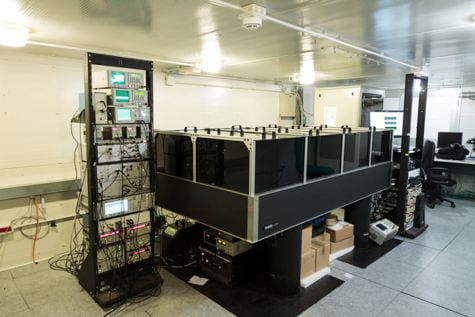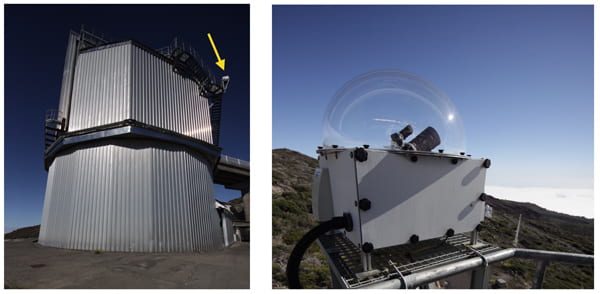Astrophysics
Astrophysical spectroscopy is a powerful tool to study the properties of stars and other astrophysical objects. In particular, the presence of planets orbiting distant stars can be inferred from spectroscopic information because a planet’s gravitational tug on its host star imprints a periodic Doppler shift on the star’s spectrum. Detecting these stellar “wobbles” — known as radial velocity (RV) changes — is possible using modern high-resolution spectrographs. However, the detection of the very small Doppler shifts induced by small, rocky planets, like Earth and Venus (RV change <10 cm/s) requires wavelength calibration precision and stability beyond conventional wavelength standards. We have developed a laser frequency comb optimized for improved wavelength calibration — known as an “astro-comb” — that we are using to advance exoplanet science as well as cosmology & fundamental physics. Additionally, stellar physics, especially the effects of magnetically active regions on stellar surfaces, can induce apparent shifts in the spectrum corresponding to RV changes >1 m/s. To characterize and correct such shifts we have built a custom small telescope to study the one star whose velocity we know with certainty: the Sun.
Astro-Comb
Laser frequency comb technology addresses spectrograph wavelength calibration by providing a stable and ultra-precise optical ruler that can ultimately be referenced to an atomic clock. In addition to exoplanet research, frequency combs may also enable measurements of astrophysical dynamics relevant to cosmology. To this end, our group has pioneered the development of laser frequency combs for astrophysical applications, i.e. “astro-combs”. Our astro-comb architecture consists of a mode-locked Ti:sapphire laser, a photonic crystal fiber for nonlinear wavelength conversion into the middle of the visible spectrum, and a set of Fabry-Perot mode filters used for repetition rate multiplication. We have successfully deployed a green astro-comb at the Telescopio Nationale Galileo (TNG) in La Palma, Canary Islands as part of the HARPS-N project to search Earth-like exoplanets. As astro-combs gain traction as primary wavelength calibrators, we are working to improve their spectral coverage and automate their operation.

Photograph of the green astro-comb located at TNG telescope facility. The astro-comb system works reliably as a wavelength calibrator for HARPS-N with minimal tending over several months.
Solar Telescope
Despite the high-precision RV measurements possible with astro-combs, the activity of stars poses a major problem for detection of Earth-like exoplanets, as it adds large (~m/s) quasiperiodic fluctuations to the apparent RV changes, which cannot easily be discriminated from the effects of Earth-like exoplanets. To tackle this problem, we have deployed at the TNG an automated compact solar telescope that allows for disk-integrated spectroscopy of the Sun. This data is valuable to search for correlations between solar activity and spectroscopic parameters, with the goal of later applying this knowledge to Sun-like stars. We are currently developing statistical and machine learning tools to analyze this complex data set.

Left: Photograph of the TNG telescope, showing the location of our compact solar telescope. Right: Close-up of our solar telescope, taking “Sun-as-a-star” measurements.
Publications